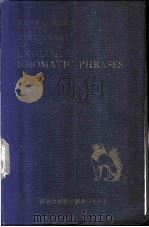《英语子句 语法和惯用法》
| 作者 | 黄子文编 编者 |
|---|---|
| 出版 | 北京:商务印书馆 |
| 参考页数 | 263 |
| 出版时间 | 1985(求助前请核对) 目录预览 |
| ISBN号 | 9017·1410 — 求助条款 |
| PDF编号 | 87538468(仅供预览,未存储实际文件) |
| 求助格式 | 扫描PDF(若分多册发行,每次仅能受理1册) |

Introduction1
Part One:Kinds of Clauses5
Chapter Ⅰ:The Coordinate Clause5
(A)Coordinators5
(B)Conjuncts12
(C)Omission of coordinator in absence of conjunct15
(D)Relative clause to serve as coordinate clause17
(E)Ellipsis in coordinate clause17
Chapter Ⅱ:The Relative Clause21
ⅰ.The Relative Pronoun21
ⅱ.Attributives and the Defining Relative Clause23
(A)Attributives23
(B)Attributives replaceable by relative clauses24
ⅲ.Omission of Relative Pronoun26
(A)Omission of relative pronoun as object26
(B)Omission of relative pronoun as subject or predicative27
ⅳ.The Preferred Relative Pronoun in a Given Case28
(A)When antecedent is personal and pronoun is subject28
(B)When verb in relative clause is"be"29
(C)If personal antecedent is not personallyidentifiable by name29
(D)When phrases intervene between antecedent and relative pronoun30
(E)When subject of relative clause is rather complex30
(F)When personal pronoun is subject of relative clause30
(G)After"those,"whether pronoun or adjective30
(H)After an adjective in the superlative degree30
(I)After most indefinite pronouns31
(J)In the emphatic mechanism"It is…"31
(K)When personal and impersonal antecedents share one rela tive31
(L)Personal relative for pet animal31
(M)Non-personal relat ive for human babies32
(N)Relative pronoun for ship always non-per-sonal32
(O)When antecedent is a collective noun32
ⅴ.Special Relative Pronouns33
(A)"What"(also"whatever")33
(B)"Whoever"and"whichever"34
(C)"As"following"such"or"as"or"the same"34
(D)"Than"following"more"premodifying a noun35
(E)"But"meaning"who not"or"which not"37
ⅵ.The Non-Defining Relative Clause38
(A)Nature of non-defining relative clause38
(B)Contrasts between non-defini ng and defining relative clauses39
(C)Points to note about non-defining relative clauses41
(D)Clause as antecedent to"which"or"as"41
(E)"As"relative versus"as"conjunctive44
ⅶ.The Relative Clause and the Non-Finite Postmodifier45
(A)Correspondence between defining relative clause and non-finite postmodifier45
(B)Correspondence between non-defining relative clause and non-finite postmodifier49
ⅷ.The Relative Adjective51
(A)"What"51
(B)"Which"51
ⅸ.The Relative Phrase54
(A)The infinitive phrase containing a relative pronoun as object54
(B)The gerund having a relative pronoun as object54
(C)The simple prepositional phrase containing a relative pronoun as object54
(D)The complex prepositional phrase with a relative pronoun as object56
(E)The non-personal possessive relative phrase56
(F)The simple prepositional phrase containing a relative adjective and a noun58
ⅹ.The Relative Adverb58
(A)Classes of relative adverbs58
Defining and non-defining relative clauses introduced by relative adverbs62
ⅹⅰ.The Compound Relative Adverb62
ⅹⅱ.The Special Relative Adverb"The"64
ⅹⅲ.Relative or Interrogative?66
ⅹⅳ.The Rule of Proximity69
(A)Priority of relative pronoun69
(B)Repetition of antecedent70
Chapter Ⅲ:The Object Clause72
ⅰ.Direct Narration and Indirect Narration72
(A)Direct speech and indirect speech72
(B)Direct question and indirect question80
ⅱ.The Object Clause85
(A)Objects to verbs86
(B)Objects to prepositions91
Chapter Ⅳ:Noun Clauses Other than the Object Clause95
(A)The subject clause95
(B)The predicative clause96
(C)The appositive clause97
(D)The noun clause as object compement101
Chapter Ⅴ:The Temporal Clause102
(A)Temporal subordinators102
(B)Some general remarks about temporal clauses109
Chapter Ⅵ:The Causal Clause113
(A)"Because":when and how used113
(B)"As":when and how used113
(C)"Because,""as"and"since"compared114
(D)"For"and"because"114
(E)Non-defining relative clause as causal clause115
(F)Participial phrase replacing causal clause115
(G)Predicative adjective or noun positioned at beginning of sentence116
(H)Prepositional phrase replacing causal clause116
(I)Negative before"because"clause117
(J)Wrong use of"because"clause as noun clause118
(K)Occasional ellipsis in causal clause118
Chapter Ⅶ:The Manner Clause120
(A) Manner subordinators120
(B)"Like"as manner subordinator122
(C)Special expressions122
(D)Ellipsis after"as" or "as if"123
Chapter Ⅷ:The Conditional Clause124
(A)Conditional clause introduced by"if":indi-cative and subjunctive compared124
(B) Conditional clauses introduced by"suppose"and"supposing"127
(C)Condition introduced by"provided(that)" and negative condition by"unless"128
(D)Condi tion expressed by imperative mood followed by "and"clause130
(E)Condition expressed by verbless clause fol-lowed by"and"clause131
(F)Relative clause as conditional clau e131
(G)Participial phrase in lieu of conditional clause132
(H)Condition expressed by"in case"132
(I)Prepositional phrases in lieu of conditional clauses132
Chapter Ⅸ:The Purpose Clause135
Chapter Ⅹ:The Result Clause138
Chapter Ⅺ:The Concessive Clause148
(A)Concessive clause introduced by"though"or"although"148
(B)Concessive clause introduced by"e e ? if,""even though"or"if"149
(C)When predicative positioned initially,"though"replaceable by"as"150
(D)Question words ending in-ever are also used to introduce concessive clauses151
(E)"No matter"or"it doesn't matter"+the question word itself to express concession152
(F)Alternative concessive clause introduced by"whether"153
(G)Concessive clause introduced by"while"154
(H)Some fixed expressions154
(I)Concession expressed by certain preposi-tions154
Chapter Ⅻ:The Comparative Clause156
(A)Ways of expressing comparison156
(B)"Than"differently parsed163
(C)Incomplete,inconsistent or illogical com-parisons164
(D)Comparative element and comparative clause166
(E)Missing element in comparative clause167
Chapter ⅩⅢ:The Proportional Clause170
(A)Overt proportion170
(B)Covert proportion171
(C)Proportion expressed by correlative i?ems"the...the"171
Chapter:ⅩⅣ:The Comment Clause172
(A) Definition and nature of comment clause172
(B)Comment clause versus main clause173
(C)Comment clause in interrogative sentence173
(D)Relative clause as comment clause175
(E)Elaborate comment clauses176
Chapter ⅩⅤ:The Focal Clause178
(A)Sentence:ordinary form versus emphatic form178
(B)Applicability of adverbials as foci179
(C)The connective used after focal clause181
Closing Remarks on Part One184
Part Two: Coordination and Subordination of IdeasPreliminary Remarks185
Chapter ⅩⅥ:Combination of Simple Sentences by Coordination188
Exercise (18 sets of sentences)190
Chapter ⅩⅦ:Combination of Two Simple Sentences by a Relatives193
Exercise (15 sets of sentences)194
Chapter ⅩⅧ:Subordination of One of Two Simple Sentences into a Noun Clause196
Exercise(23 sets of sentences)197
Chapter ⅩⅨ:Subordination of One of Two Simple Sentences into an Adverbial Clause199
Exercise(29 sets of sentences)201
Chapter ⅩⅩ:Coordi nation and Subordination Occurring in the Same Sentence204
Exercise(27 sets of sentences)206
Chapter:ⅩⅪ:Subordination of One of Two Simple Sentences into a Phrase210
Exercise(a)—by using participles(12 sets of sentences)212
Exercise(b)—by using absolute phrases(12 sets of sentences)213
Exercise(c)—by using prepositions with nouns or gerunds (19 sets of sentences)214
Exercise(d)—by using infinitives(14 sets of sentences)215
Exercise(e)—by using nouns or phrases in apposition (5 sets of sentences)216
Exercise(f)—by using adverbs or adverbial phrases (18 sets of sentences)217
Exercise(g)—by miscellaneous methods(43 sets of sentences)218
Exercise(h)—by subordinating in as many ways as possible (9 sets of sentences)221
Chapter ⅩⅫ:Coordination Versus Subordination223
Exercise For (a)—10 sentences224
Exercise For (b)—9 sentences225
Exercise For (c)—10 sentences225
Exercise For (d)—10 sentences226
Chapter ⅩⅩⅢ:Complicated Subordination227
Exercise(a)—Combine into one complex sen-tence (13 sets of sentences)229
Exercise(b)—Rewrite to show proper subor-dination and coordination (8 sen-tences)231
Exercise(c)—Rewrite by using subordination as far as possible (4 paragraphs or sentence groups)233
Appendices235
Appendix235
1—Key to Exercise in Chapter ⅩⅥ235
2—Key to Exercise in Chapter ⅩⅦ237
3—Key to Exercise in Chapter ⅩⅧ238
4—Key to Exercise in Chapter ⅩⅨ240
5—Key to Exercise in Chapter ⅩⅩ242
6—Keys to Exercises in Chapter ⅩⅪ(Exercises[a]to[h])245
7—Keys to Exercises in Chapter ⅩⅫ(Exercises for[a]to[d])256
8—Keys to Exercises in Chapter ⅩⅩⅢ(Exercises[a]to[c])258
1985《英语子句 语法和惯用法》由于是年代较久的资料都绝版了,几乎不可能购买到实物。如果大家为了学习确实需要,可向博主求助其电子版PDF文件(由黄子文编 1985 北京:商务印书馆 出版的版本) 。对合法合规的求助,我会当即受理并将下载地址发送给你。
高度相关资料
-

- 英语句法
- 1989 商务出版社
-

- 英语句型和惯用法
- 1981.03
-

- 英语动词 语法和惯用法
- 1981.02
-

- 英语惯用法词典
- 1958
-

- 英文惯用语的起源和用法
- 大方文化事业公司
-

- 英语惯用句小辞典
- 1959
-

- 英语惯用法手册
- 济南教师进修学院
-

- 英语惯用语用法手册
- 外语学习社
-

- 现代英语句型与惯用法
- 华联出版社
-

- 英语语法与惯用法
- 1999 长沙:国防科技大学出版社
-

- 基础英语惯用法
- 1991 广州:广东教育出版社
-

- 英语惯用法大词典
- 1995 北京:北京科学技术出版社
-

- 新编日语语法教程
- 1987 上海:上海外语教育出版社
-

- 英语介词惯用法
- 1981 北京:北京师范大学出版社
-

- 英语常用短语词汇
- 1996 北京市:兵器工业出版社
提示:百度云已更名为百度网盘(百度盘),天翼云盘、微盘下载地址……暂未提供。➥ PDF文字可复制化或转WORD